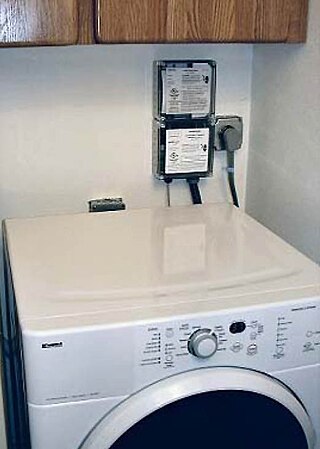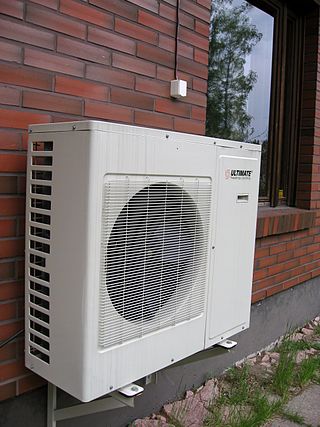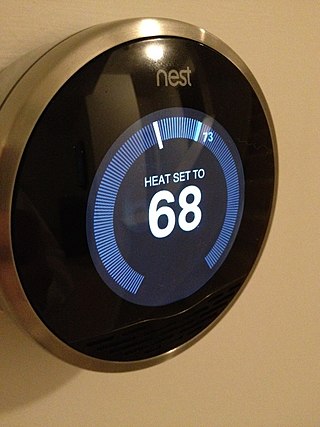
Automatic meter reading (AMR) is the technology of automatically collecting consumption, diagnostic, and status data from water meter or energy metering devices and transferring that data to a central database for billing, troubleshooting, and analyzing. This technology mainly saves utility providers the expense of periodic trips to each physical location to read a meter. Another advantage is that billing can be based on near real-time consumption rather than on estimates based on past or predicted consumption. This timely information coupled with analysis can help both utility providers and customers better control the use and production of electric energy, gas usage, or water consumption.

Energy conservation is the effort to reduce wasteful energy consumption by using fewer energy services. This can be done by using energy more effectively or changing one's behavior to use less service. Energy conservation can be achieved through efficient energy use, which has some advantages, including a reduction in greenhouse gas emissions and a smaller carbon footprint, as well as cost, water, and energy savings.
Green computing, green IT, or ICT sustainability, is the study and practice of environmentally sustainable computing or IT.
Software as a service is a form of cloud computing in which the provider offers the use of application software to a client and manages all the physical and software resources used by the application. The distinguishing feature of SaaS compared to other software delivery models is that it separates "the possession and ownership of software from its use". SaaS began around the turn of the twenty-first century and became the main form of software application deployment by 2023.

Demand response is a change in the power consumption of an electric utility customer to better match the demand for power with the supply. Until the 21st century decrease in the cost of pumped storage and batteries, electric energy could not be easily stored, so utilities have traditionally matched demand and supply by throttling the production rate of their power plants, taking generating units on or off line, or importing power from other utilities. There are limits to what can be achieved on the supply side, because some generating units can take a long time to come up to full power, some units may be very expensive to operate, and demand can at times be greater than the capacity of all the available power plants put together. Demand response, a type of energy demand management, seeks to adjust in real-time the demand for power instead of adjusting the supply.

Negawatt power is investment to reduce electricity consumption rather than investing to increase supply capacity. In this way, investing in negawatts can be considered as an alternative to a new power station and the costs and environmental concerns can be compared.

A smart meter is an electronic device that records information—such as consumption of electric energy, voltage levels, current, and power factor—and communicates the information to the consumer and electricity suppliers. Such an advanced metering infrastructure (AMI) differs from automatic meter reading (AMR) in that it enables two-way communication between the meter and the supplier.
The Texas electricity market is deregulated, meaning that there is competition in the generation and distribution of electricity. Power generators in the Texas Interconnection, managed by the Electric Reliability Council of Texas, participate in an energy-only electricity market and are compensated only for the electricity they produce. The wholesale generation market was deregulated in 1995 and the distribution market in 1999, with Texas Senate Bill 7. This replaced the prior system in which power was generated and consumed locally by the same utility with one in which retail providers contracted with generators across the state.
Energy monitoring and targeting (M&T) is an energy efficiency technique based on the standard management axiom stating that “you cannot manage what you cannot measure”. M&T techniques provide energy managers with feedback on operating practices, results of energy management projects, and guidance on the level of energy use that is expected in a certain period. Importantly, they also give early warning of unexpected excess consumption caused by equipment malfunctions, operator error, unwanted user behaviours, lack of effective maintenance and the like.

In environmental policy, white certificates are documents certifying that a certain reduction of energy consumption has been attained. In most applications, the white certificates are tradable and combined with an obligation to achieve a certain target of energy savings. Under such a system, producers, suppliers or distributors of electricity, gas and oil are required to undertake energy efficiency measures for the final user that are consistent with a pre-defined percentage of their annual energy deliverance. If energy producers do not meet the mandated target for energy consumption they are required to pay a penalty. The white certificates are given to the producers whenever an amount of energy is saved whereupon the producer can use the certificate for their own target compliance or can be sold to (other) parties who cannot meet their targets. Quite analogous to the closely related concept of emissions trading, the tradability in theory guarantees that the overall energy saving is achieved at least cost, while the certificates guarantee that the overall energy saving target is achieved.
The Climate Savers Computing Initiative was a nonprofit group of consumers, businesses and conservation organizations dedicated to promoting smart technologies that improve power efficiency and reduce energy consumption of computers. Formed in 2007, it was based in Portland, Oregon. In July 2012, Climate Savers Computing Initiative combined with The Green Grid and its programs continue within that organization.
GridPoint is an American clean technology company based in Reston, Virginia, that provides energy management and sustainability services to enterprises and government agencies, such as electric utilities.

A home energy monitor is a device that provides information about a personal electrical energy usage to a consumer of electricity. Devices may display the amount of electricity used, plus the cost of energy used and estimates of greenhouse gas emissions. The purpose of such devices is to assist in the management of power consumption. Several initiatives has been launched to increase the usage of home energy monitors. Studies have shown a reduction of home energy when the devices are used.
Meter data management (MDM) refers to software that performs long-term data storage and management for the vast quantities of data delivered by smart metering systems. This data consists primarily of usage data and events that are imported from the head-end servers managing the data collection in advanced metering infrastructure (AMI) or automatic meter reading (AMR) systems. MDM is a component in the smart grid infrastructure promoted by utility companies. This may also incorporate meter data analytics, the analysis of data emitted by electric smart meters that record consumption of electric energy.
The United States has the second largest electricity sector in the world, with 4,178 Terawatt-hours of generation in 2023. In 2023 the industry earned $491b in revenue at an average price of $0.127/kWh.

PECI is a private, non-profit American company based in Portland, Oregon with additional offices in Santa Ana, California and San Francisco, California. PECI designs and manages energy efficiency programs for utility providers, government organizations, and other clients. Some of the organizations PECI has worked with include the U.S. Department of Energy, Avista, Wal-mart, Southern California Edison, the Community Energy Project, Energy Trust of Oregon, Pacific Gas & Electric and the San Diego Natural History Museum.
Opower was an American company founded in 2007, that provides a software-as-a-service customer engagement platform for utilities. It existed as an independent corporation until its acquisition by Oracle Corporation in 2016. The Opower product line is under the Oracle Utilities global business unit.
Home Energy Saver is a set of on–line resources developed by the U.S. Department of Energy at the Lawrence Berkeley National Laboratory intended to help consumers and professional energy analysts, analyze, reduce, and manage home energy use.

Smart thermostats are Wi-Fi thermostats that can be used with home automation and are responsible for controlling a home's heating, ventilation, and air conditioning. They perform similar functions as a Programmable thermostat as they allow the user to control the temperature of their home throughout the day using a schedule, but also contain additional features, such as sensors and Wi-Fi connectivity, that improve upon the issues with programming.

Raffi Krikorian is an Armenian-American technology executive, and the CTO of the Emerson Collective. He was the CTO of the Democratic National Committee, Head of Uber's Advanced Technologies Center, and the former VP of Platform Engineering at Twitter where he was in charge of infrastructure for all of Twitter up to August 2014. He is credited with leading the charge to improve the reliability of Twitter as well as the move from Ruby to the JVM. He currently also serves on the board of directors of the Tumo Center for Creative Technologies in Yerevan, Armenia.









